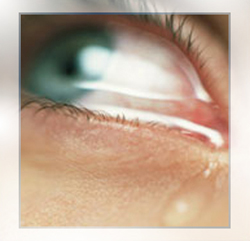Computer vision syndrome appears after 4 hours of work with PC
The human vision does not fit the work with computer images
Watching television or reading in the dark and in public transport was considered to be two major aspects that caused the biggest damage to human eyesight. The list has now been added with another hazard – personal computers. 
American medics from the association of optometrists (who check the acuity of people's vision) introduced a new term in the medical practice – the Computer Vision Syndrome, CVS. The CVS is a specific eye disorder of those people, who spend much time in front of computer screens.
One can separate all CVS symptoms into three main groups. The “vision group” is connected with worsening vision, and the other one, the “eye group” is connected with unpleasant feelings in the eyes.
Vision symptoms are as follows:
worsening eyesight;
slower refocusing from close and distant objects of viewing and vice versa (accommodation disturbance);
seeing double objects;
rapid fatigability from reading.
In addition to these symptoms, the CVS develops a peculiar visual illusion: if you shift your look from the screen to a black or a white object, it will take the color, which was predominant on the computer screen.
Eye symptoms are as follows:
burning sensation in the eyes;
”sand” underneath the eyelids;
painful feelings in eye-sockets and forehead;
eye movement pains;
red eyes.
The majority of PC users start complaining of eye discomfort after four hours of work. Almost all users experience discomfort after six hours of work at a computer. It is easier for the eyes to read the information from the screen than to upload it in a PC. Computer graphics and the dialogue regime of working cause the strongest weariness to the eyes.
The human vision does not fit the work with computer images, which differ a lot from natural objects. The glowing computer screen creates insufficiently contrasting pictures, which do not have precise borders. In addition, computer images are made of countless shimmering pixels. Glare on walls and finished surfaces, reflections on the screen, improper distance between the eyes and the screen add more fuel to the fire and make the computer work extremely tiresome. In addition, the eye fatigue occurs faster, if one has to constantly move the look from the screen and on the keyboard or on paper sheets.
It took doctors a lot of time to find out if the computer monitor causes the actual eye damage or not. Modern medicine has not found an answer to this question yet. Computers do not develop either cataract or glaucoma. Shortsightedness is the only change that can occur.
As a rule, doctors recommend to spend less time working at computers, adjust the brightness of the screen, blink more often and take frequent breaks. It is also important to purchase a high-quality monitor. Up-to-date scientific developments offer super-modern high-resolution screens. To crown it all, electron-ray tubes gradually give way to LCD screens. Laptop screens are especially ergonomic at this point.
Those people, who suffer from the Computer Vision Syndrome, can use special computer glasses to protect their eyes. One may find a variety of special eyewear, in which the clear vision zone corresponds to look shifts during the screen work. The special paint of glass lenses is very important too. The Russian Institute of Biochemical Physics of the Russian Academy of Sciences in cooperation with the Moscow Institute of Eye Diseases developed color lens coatings several years ago to increase the image contrast. The use of such glasses considerably reduces the eye fatigue and improves the focusing in comparison with other glasses.
Subscribe to Pravda.Ru Telegram channel, Facebook, RSS!





